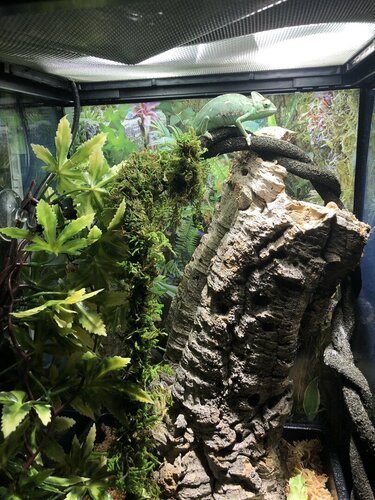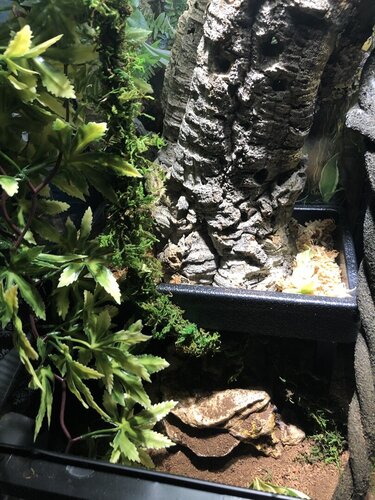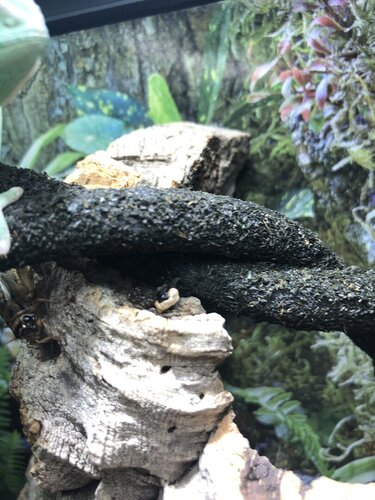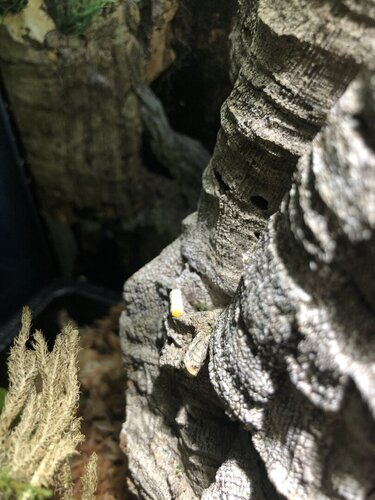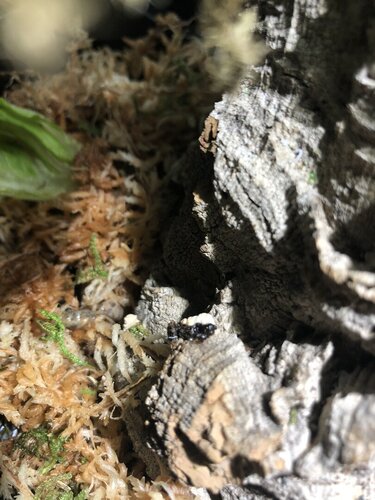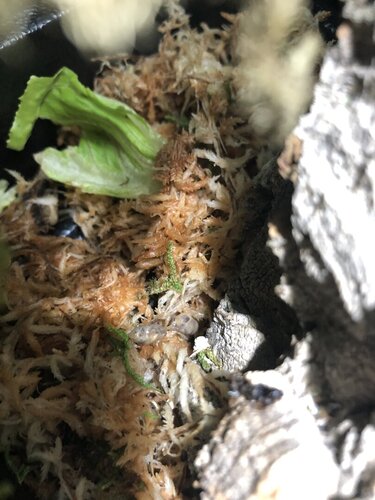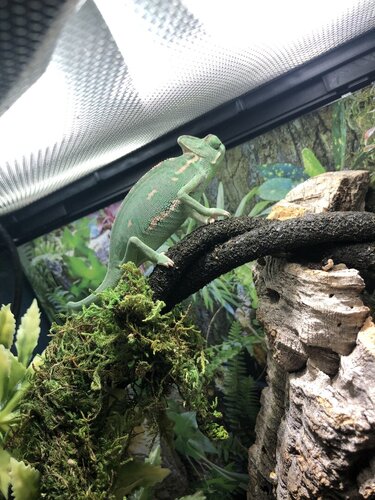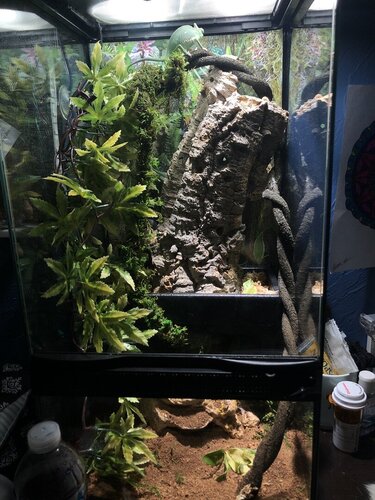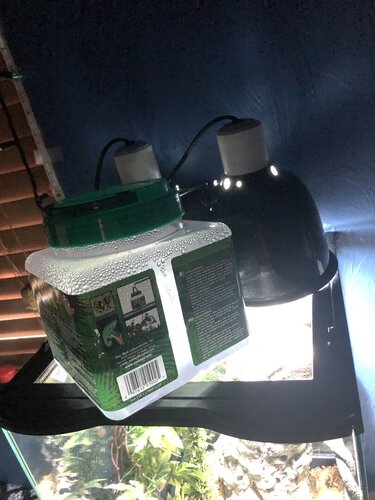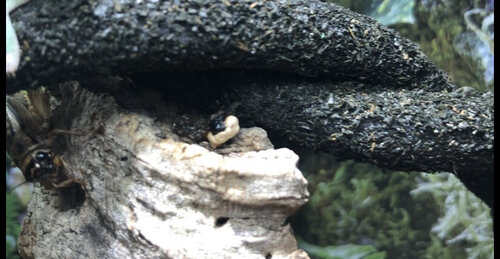Navigation
Install the app
How to install the app on iOS
Follow along with the video below to see how to install our site as a web app on your home screen.
Note: This feature may not be available in some browsers.
More options
You are using an out of date browser. It may not display this or other websites correctly.
You should upgrade or use an alternative browser.
You should upgrade or use an alternative browser.
Zillas not eating
- Thread starter eliska
- Start date
MissSkittles
Chameleon Enthusiast
Hi and welcome to the forum.  Afraid We’ll need much more information to try to help. If you could also provide pics of your entire enclosure, from lights to floor, that often helps a great deal too.
Afraid We’ll need much more information to try to help. If you could also provide pics of your entire enclosure, from lights to floor, that often helps a great deal too.
Here is some recommended information to include when asking for help in the health clinic forum. By providing this information you will receive more accurate and beneficial responses. It might not be necessary to answer all these questions, but the more you provide the better. Please remember that even the most knowledgeable person can only guess at what your problem may be. Only an experienced reptile veterinarian who can directly examine your animal can give a true diagnosis of your chameleon's health.
Chameleon Info:
--------------
Please Note:
Here is some recommended information to include when asking for help in the health clinic forum. By providing this information you will receive more accurate and beneficial responses. It might not be necessary to answer all these questions, but the more you provide the better. Please remember that even the most knowledgeable person can only guess at what your problem may be. Only an experienced reptile veterinarian who can directly examine your animal can give a true diagnosis of your chameleon's health.
Chameleon Info:
- Your Chameleon - The species, sex, and age of your chameleon. How long has it been in your care?
- Handling - How often do you handle your chameleon?
- Feeding - What are you feeding your cham? What amount? What is the schedule? How are you gut-loading your feeders?
- Supplements - What brand and type of calcium and vitamin products are you dusting your feeders with and what is the schedule?
- Watering - What kind of watering technique do you use? How often and how long to you mist? Do you see your chameleon drinking?
- Fecal Description - Briefly note colors and consistency from recent droppings. Has this chameleon ever been tested for parasites?
- History - Any previous information about your cham that might be useful to others when trying to help you.
- Cage Type - Describe your cage (Glass, Screen, Combo?) What are the dimensions?
- Lighting - What brand, model, and types of lighting are you using? What is your daily lighting schedule?
- Temperature - What temp range have you created (cage floor to basking spot)? Lowest overnight temp? How do you measure these temps?
- Humidity - What are your humidity levels? How are you creating and maintaining these levels? What do you use to measure humidity?
- Plants - Are you using live plants? If so, what kind?
- Placement - Where is your cage located? Is it near any fans, air vents, or high traffic areas? At what height is the top of the cage relative to your room floor?
- Location - Where are you geographically located?
--------------
Please Note:
- The more details you provide the better and more accurate help you will receive.
- Photos can be very helpful.
eliska
New Member
When I got Zilla they said they were unsure of how old she was but she’s definitely still a juvenile. I feed her crickets about 2 in the morning and 2 at night. I’ve been feeding her small crickets but i’ve gotten bigger ones. Before i feed her crickets i sprinkle the repashy calcium on the crickets. i feed the crickets lettuce and potatoes sometimes. they have a sponge like thing which holds water for them. i dont know why she wont eat i’ve been giving her like 2 worms once a week?
Attachments
I would fill out the form that was posted above with detail. We need specifics on humidity, temps, the exact supplements your using etc.
At that age they eat much more then 2-4 a day. Just with the enclosure set up there will need to be changes to the size of enclosure and the way it is set up and the UVB lighting.
At that age they eat much more then 2-4 a day. Just with the enclosure set up there will need to be changes to the size of enclosure and the way it is set up and the UVB lighting.
DeadFxce
Member
I very recently had this problem and my Cham just started eating listen too miss skittles for everything I’ll need I could be due too stress or her being she maybe uninterested what kind of worms were u tryingAlso i’ve had her for about two weeks now i only handle her when she wants to come so a couple times a week and i take her outside to get occasional sunlight
DeadFxce
Member
U could try a worm based diet I’ve been giving my Cham 1 wax worm 6 Calci worms and a super worm daily with calcium she loves them and never refuses to eatI very recently had this problem and my Cham just started eating listen too miss skittles for everything I’ll need I could be due too stress or her being she maybe uninterested what kind of worms were u trying
DeadFxce
Member
What is ur method of feedingU could try a worm based diet I’ve been giving my Cham 1 wax worm 6 Calci worms and a super worm daily with calcium she loves them and never refuses to eat
eliska
New Member
mealwormsI very recently had this problem and my Cham just started eating listen too miss skittles for everything I’ll need I could be due too stress or her being she maybe uninterested what kind of worms were u trying
DeadFxce
Member
Meal worms are not recommended the exoskeleton may make it hard for them to digest try calci worms Phoenix worms or black solider fly larvaemealworms
Unfortunately this is not a recommended staple diet... None of these can be properly gutloaded. Wax worms are higher in fat. The key is diversity. Adding different feeders in so that they get a combination of feeders some gutloaded and then others that are not.U could try a worm based diet I’ve been giving my Cham 1 wax worm 6 Calci worms and a super worm daily with calcium she loves them and never refuses to eat
Please fill out the form so the experienced members may give you thorough feedback. Copy and paste it then fill it out with detail please. Make sure your scrolling through the posts in your thread as you will not get alerts for every post done. There are multiple things that really need to be corrected with the enclosure.thank you! how many times a week and how many?
Chameleon Info:
- Your Chameleon - The species, sex, and age of your chameleon. How long has it been in your care?
- Handling - How often do you handle your chameleon?
- Feeding - What are you feeding your cham? What amount? What is the schedule? How are you gut-loading your feeders?
- Supplements - What brand and type of calcium and vitamin products are you dusting your feeders with and what is the schedule?
- Watering - What kind of watering technique do you use? How often and how long to you mist? Do you see your chameleon drinking?
- Fecal Description - Briefly note colors and consistency from recent droppings. Has this chameleon ever been tested for parasites?
- History - Any previous information about your cham that might be useful to others when trying to help you.
Cage Info:
- Cage Type - Describe your cage (Glass, Screen, Combo?) What are the dimensions?
- Lighting - What brand, model, and types of lighting are you using? What is your daily lighting schedule?
- Temperature - What temp range have you created (cage floor to basking spot)? Lowest overnight temp? How do you measure these temps?
- Humidity - What are your humidity levels? How are you creating and maintaining these levels? What do you use to measure humidity?
- Plants - Are you using live plants? If so, what kind?
- Placement - Where is your cage located? Is it near any fans, air vents, or high traffic areas? At what height is the top of the cage relative to your room floor?
- Location - Where are you geographically located?
Current Problem - The current problem you are concerned about.
--------------
Please Note:
- The more details you provide the better and more accurate help you will receive.
- Photos can be very helpful.
DeadFxce
Member
Around 8 a bsfl a day and 1 wax worms or super worm few times a weekthank you! how many times a week and how many?
MissSkittles
Chameleon Enthusiast
I feed my chams a variety of feeders...discoid roaches, silkworms, bsfl, crickets, occasionally a superworm and let the bsfl hatch into flies for flying treats. Variety is best as @Beman said. Answering the help questions will only be of benefit to you and your cham. Having a female, husbandry needs to be spot on or you and she could run into serious problems when egg laying starts.
eliska
New Member
- Your Chameleon - Veiled chameleon, im pretty sure shes a female, petco didnt tell me how old she is but ive had her for 2 weeks
- Handling - i take her out everyday she always comes with no hesitation
- feeding- i feed her crickets but ive recently got the bigger ones so i give her like maybe 4-6 a day but she hasnt been eating. i prepare the crickets with calcium before tho.
- Supplements - i use the repashy calcium
- Watering - i have the little dripper and i let it drip 5-10 min twice a day and i mist the fake plants too
- Fecal Description - it seems pretty normal to me i can provide a picture
- History - Any previous information about your cham that might be useful to others when trying to help you.
Cage Info:
- Cage Type - glass cage i think its like 16x16
- Lighting - not sure it came in the cage kit but she gets 12 hours of light
- Temperature - need a thermostat
- Humidity - What are your humidity levels? How are you creating and maintaining these levels? What do you use to measure humidity?
- Plants - idk what live plants to put in
- Placement - my cage is on my desk which is the high place in my room.
- Location - florida
Attachments
MissSkittles
Chameleon Enthusiast
Give me a few minutes and I’ll do a full review. 
MissSkittles
Chameleon Enthusiast
Putting my feedback in red.
- Your Chameleon - Veiled chameleon, im pretty sure shes a female, petco didnt tell me how old she is but ive had her for 2 weeks I’m not the greatest at figuring out age, but I’d guess maybe 4-5 months old.
- Handling - i take her out everyday she always comes with no hesitation
- feeding- i feed her crickets but ive recently got the bigger ones so i give her like maybe 4-6 a day but she hasnt been eating. i prepare the crickets with calcium before tho. If the crickets are too big, she may not want to or be able to eat them. Rule for feeders is anything larger than the space between their eyes is too big. Are you gutloading the crickets? It’s important to gutload well in order to pass nutrients on to your cham. Attaching gutload sheet. You already have been given feeder sheet. Variety is best. She should probably be having at least 6-8 feeders daily, depending on if she’s as young as I think.
- Supplements - i use the repashy calcium Which one? Supplements are super important and I need to know which you have and are using.
- Watering - i have the little dripper and i let it drip 5-10 min twice a day and i mist the fake plants too You should be misting for at least 2 minutes twice daily...early AM and right before lights out...along with using the dripper at least for 15 minutes mid day.
- Fecal Description - it seems pretty normal to me i can provide a picture I always suggest getting a fecal check for parasites.
- History - Any previous information about your cham that might be useful to others when trying to help you.
- Cage Type - glass cage i think its like 16x16 This is much too small. Also, being in Florida the humidity is high. You’ll need to get a minimum enclosure of 2x2x4’ and I suggest it be all screen.
- Lighting - not sure it came in the cage kit but she gets 12 hours of light From your pics, your uvb is not correct and not able to provide adequate uvb levels. You need a linear T5 ho fixture with either a 5.0 or Arcadia 6% uvb bulb. Uvb and basking lights should be at least 8-9” from basking area.
- Temperature - need a thermostat Yes, you do. If it’s too cool, she won’t be able to digest her food properly and her metabolism will slow. If too high, she could be burning up. Ideal temp for her is 80-82* at basking spot. A larger enclosure will provide different gradients she can go to if she wants to cool off.
- Humidity - What are your humidity levels? How are you creating and maintaining these levels? What do you use to measure humidity? Hygrometers measure humidity and this is just as important as knowing your temperatures. High humidity combined with high heat increases chances of respiratory infections. Ideal humidity during the day is between 30-50%, which is much dryer than we tend to think.
- Plants - idk what live plants to put in Easiest plants are pothos and philodendron. They grow fast, have long vines to spread around and provide additional cham roads, big leaves to drink from and hide in, no special lights needed and since veileds nibble their plants, it’s safe for her. Dracaena is very nice, as is Schefflera, but they may need some grow lights.
- Placement - my cage is on my desk which is the high place in my room.
- Location - florida
PabloTheCham
Chameleon Enthusiast
Its kind of a little late to feed, they need the whole day to digest.she’s eating again!
Similar threads
- Replies
- 13
- Views
- 500





